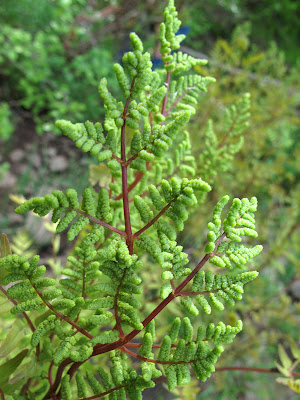The Walking Fern (Asplenium rhizophyllum) was one of the most exciting for me. It was the first time I had ever seen one or notice one. In birder terms it was a "life" fern.
It doesn't look like a typical fern so I might have just over looked it before. One of the unique characteristics of this fern is that where the tips touch the ground a new plant is formed so it is not dependent on the spores to take root. This strategy works well for this limestone rock and cliff loving ferns. Apparently the spores are unreliable, perhaps because they are easily washed off the rocks and can't find a suitable substrate, I'm not certain but I think that is the reason. Anyway that is why it is called a "walking fern" because it moves across the ground as it spreads.
It is an evergreen fern that has a leathery feel. Below is a photo of the sori or fruit dots.
We found a couple Wild Columbines (Aquilegia canadensis) growing in the limestone cliffs near the walking fern. The round end of the spur is where the delicious nectar is stored.
Jack-in-the-Pulpit (Arisaema triphyllum) is aways a favorite of mine to see.
Of course I had to lift the lid to see if Jack was inside. They are poisonous if ingested and I imagine would make a good weapon in a Miss Marple mystery book..."Death by the Pulpit".
Someone noticed a Pipevine Swallowtail Butterfly (Battus philenor) and lo and behold it flew to a Pipevine flower. These are the host plant for the caterpillar stage of the adult butterfly. There is something in the Pipevine plant that makes the larvae and adults poisonous to those who feed on the insect. In this way they are similar to Monarchs that are protected by the qualities of the milkweed that make them toxic. Hummm, I wonder if we could have another murder mystery book titled "Death by Pipe".
The flowers were hanging over the water so I didn't get a good photo but from a distance they certainly look like the old fashioned pipes that the common name comes from.
Another new fern for me was the Deparia acrostichoides (Silvery Glade Fern).
The indusia turn silvery when the sori are close to ripening, hence the name.
Caulophyllum thalictroides (Blue Cohosh)
I love the leaves of this plant which has a lot of medical uses.Maianthemum canadense (Canada Mayflower)
Botrychium virginianum (Rattlesnake Fern)
I love this easily over looked fern. The story goes that in the spring the fertile frond, pictured below, points toward ginseng. There was ginseng in the area but the fern wasn't pointing to it and it was not the valuable species that is being uprooted for profit. So much for mountain stories.
Early on in the development of the fertile frond it does look like the rattle end of a rattle snake but here it is a little more mature and spread out.
Sedum ternatum (Wild Stonecrop or Woodland Stonecrop) is widespread through my area. This was found on the cliffs beside a runoff waterfall. I just read about a species found at Larenim Park in Mineral County, WV. That is a nice little park with two lakes for fishing and you can find some interesting plants and butterflies there as well.
Senecio aureus (Golden ragwort) was abundant.
Osmunda regalis (Royal Fern).
I was not prepared for how tall this fern was...40 inches...I had read that but it doens't really sink in until you are standing next to one. It certainly deserves the name Royal because of that grand height. In many areas, it has become rare as a result of wetland drainage for agriculture and even here along the river there was just this small stand of them.
There were still fiddleheads on some and fertile fronds opening on others.
I think the Trillium undulatum (Painted Trillium) was the prettiest flower find of the day.
Smilax rotundifolia (Common Greenbriar or Stay-a-while vine) was a fun vine to learn about. One of the naturalist broke off the tip and began to eat it. I tried a bit myself and will have to admit the mild lemon flavor was tasty and would make a nice addition to a salad. Last weekend I thought I would try it again and share it with my nature reading book group but I broke off wild grape vine instead and that was rather yucky tasting so I certainly didn't share that. He also called it the "Stay-a-while" vine which if you have ever been caught up in it will know exactly what he means. Those sharp spines don't easily let go.
I saw many more ferns and flowers but these where the highlights of the day.
To see more interesting flowers visit Todays Flowers.




+IMG_6285b.jpg)



+IMG_6327.JPG)

+IMG_6403.JPG)


IMG_6245.JPG)
+IMG_6541.JPG)




+IMG_6527.JPG)



+DSCN5800+for+blog.jpg)




5 comments:
What a great day. So many new ferns I've never seen that don't grow in our dry limestone environment. I always looked under the pulpit for Jack when I wandered the woods in IL. Could be just "Death in the Forest"
Every day something new and delightful to see. That Walking Fern was quite a find. It's a true limestone lover. Thanks for taking us along on your walk.
I really meant to take that Blackwater wildflower walk this past May but decided that I didn't have the time. Now I'm sorry. Perhaps I'll see you there next year. I think my fern garden needs a walker.
We move in closer, our visibility aided by the flash of my Panasonic. Filmy Fern grows in tight clumps...Trees For Sale
And finally, a return to ferns! In addition to all the beautiful early spring flowering plants at Abraham's Woods, there are a number of ferns as well. trees for sale
Post a Comment